What are nutrients?
The nutrients nitrogen (N) and phosphorus (P) are elements, and are essential building blocks for plant and animal growth. Nitrogen is an integral component of organic compounds such as amino acids, proteins, DNA and RNA. Phosphorus is found in nucleic acids and certain fats (phospholipids). Most of the earth’s atmosphere (~78%) is made of dinitrogen gas (N2), whereas phosphorus is a common element of igneous rocks. Chemical and biological processes transfer nitrogen and phosphorus through the lithosphere, atmosphere, hydrosphere and biosphere. This is called nitrogen and phosphorus cycling. Nitrogen-fixing bacteria convert dinitrogen gas into organic nitrogen species that can enter the hydrological cycle and food webs. Phosphorus is made biologically available through the weathering of rocks.
Silicon and several metals are also often classified as nutrients. The metals, such as copper, zinc and chromium, present at low concentrations in water, are essential for life and are called micronutrients or trace elements. However, they can become toxicants when they are found at higher than background concentrations in the environment.
Occurrence of nitrogen in coastal waterways
Nitrogen exists in water both as inorganic and organic species, and in dissolved and particulate forms. Inorganic nitrogen is found both as oxidised species (e.g. nitrate (NO3-) and nitrite (NO2-)) and reduced species (e.g. ammonia (NH4++NH3) and dinitrogen gas (N2)). The occurrence of the different forms of ammonia depend on pH. At the pH of average seawater, ~95% of ammonia is in the cationic form which is called ammonium (NH4+). However, roughly half the ammonia will be in the (toxic) gaseous form (NH3), if the pH rises to ~9.5 in seawater2. Total dissolved nitrogen (TDN) consists of dissolved inorganic nitrogen (DIN) and dissolved organic nitrogen (DON), and is readily available for plant uptake. DIN comprises NO2-+NO3++NH4+. Dissolved organic nitrogen is found in a wide range of complex chemical forms such as amino acids, proteins, urea and humic acids. Ammonium is the form of nitrogen taken up most readily by phytoplankton because nitrate must first be reduced to ammonia before it is assimilated into amino acids in organisms. The particulate nitrogen pool consists of plants and animals, and their remains, as well as ammonia adsorbed onto mineral particles. Particulate nitrogen can be found in suspension or in the sediment (see sediment organic matter). Some portion of the particulate nitrogen pool is subject to rapid mineralisation, and is biologically available. Total nitrogen (abbreviated TN) is a measure of all forms of dissolved and particulate nitrogen present in a water sample.
Occurrence of phosphorus in coastal waterways
Phosphorus is found in waterbodies in dissolved and particulate forms. Dissolved phosphorus is readily available for plants, and consists of inorganic orthophosphate (e.g. H2PO4-, HPO42-, PO43-) and organic phosphorus-containing compounds (DOP). The particulate phosphorus pool consists of plants and animals, and their remains, phosphorus in minerals (e.g. fluorapatite) and phosphate adsorbed onto iron oxyhydroxides on mineral surfaces. Particulate phosphorus can be found in suspension or in the sediment (see sediment organic matter). The adsorption and desorption of phosphate from mineral surfaces forms a buffering mechanism that regulates dissolved phosphate concentrations in rivers and estuaries3. Total phosphorous (abbreviated TP) is a measure of all the various forms of phosphorus (dissolved and particulate) found in water.
Nutrient loads, nutrient concentrations and nutrient budgets
Nutrients are conveyed to coastal waterways from catchment, atmospheric and oceanic sources. A nutrient load is an estimate of the total amount of a nutrient (N or P) that enters a waterway (of area ‘x’) over time interval ‘y’ (usually a year) in units of N or P metre-2 year-1 (or similar). Nutrient concentration measurements refer to the amount (mass or moles) of a nutrient in a volume of water (usually per litre) or in a mass of sediment. Nutrient budgets define all the inputs, outputs or storage of nutrients in a system, or in a specified region (see example in Figure 1).
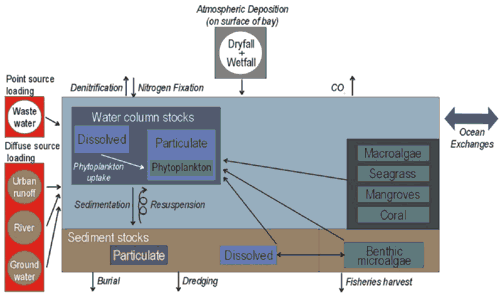
Figure 1. Conceptual model of a nutrient budget from Moreton Bay (Qld) illustrating nutrient sources, recycling pathways, storages and losses. Adapted after Boynton et al. (1995) by Dennison and Abal (1999)4. Reproduced with permission of the Healthy Waterways Library.
What causes nutrient loads to change?
- Nutrient loads are enhanced by human activity. Major anthropogenic sources of nutrients include runoff from agricultural areas (e.g. fertilisers), urban stormwater and wastewater (including sewage), eroded soils and aquaculture. Anthropogenically-derived nutrients often enter coastal waterways in pulsed events. Point sources of nutrients are generally less important nutrient contributors than diffuse (non-point) sources (e.g. from stormwater and agricultural runoff), but still can have significant impacts on coastal waterways.
- In Australia, nitrogen and phosphorus export in rivers (to coastal waterways) increases with the extent of catchment cleared, and the predominant form of N changes from DON to DIN5.
- Turbidity and nutrient exceedances generally coincide in Australia’s river systems highlighting the important role that suspended sediments (and colloids) play in transporting particulate nutrients through the landscape (and ultimately to coastal waterways)6. A large proportion of the suspended sediment in Australian rivers results from vegetation removal, leading to gully and streambank erosion and sheetwash7. Phosphorus is overwhelmingly associated with such particulate loads8.
- Bacterial nitrogen fixation is usually a minor source of nitrogen in coastal waterways. The microbial flora which fix nitrogen are often found in association with seagrasses where they are supported by the dissolved organic carbon released from roots and rhizomes. However, nitrogen fixation is an important source of nitrogen in coral reefs, where it may offset losses of N due to export.
- ‘Recycled’ nutrients released from the sediment during the decomposition of organic matter constitute an ‘internal nutrient load’. Benthic recycling of nutrients can be an important component of annual nutrient budgets in some coastal waterways. For example, benthic recycling accounts for 63 and 72% of the annual nitrogen and phosphorus inputs respectively in Port Phillip Bay9. Note however, that this regenerated load came originally from the catchment, and largely in organic form. Therefore it is not a new load as such. This is an important point that is frequently overlooked when the conclusion is drawn from budget calculations, that the catchment itself is a minor contributor to nutrient loads in coastal systems compared with the internal sources.
- Denitrification is a major sink for inorganic nitrogen in estuaries910. Nitrogen loss due to denitrification can exceed 50% of the total nitrogen input, and is probably the main reason why nitrogen can sometimes be the limiting nutrient in estuaries11.
- Nitrification is inhibited when sediments are anoxic, and this can cause a lowering of denitrification efficiencies. Under such conditions, relatively less nitrogen may be vented to the atmosphere as N2 gas, and relatively more nitrogen may be returned to the water column as ammonium (unless denitrification is coupled to water column nitrate).
- Water column phosphorus concentrations have also been shown to increase under anoxic conditions 12. This is because some of the iron oxyhydroxides that bind phosphate are converted to iron sulfides during sulfate reduction (an anaerobic process) and the iron sulfides cannot bind phosphorus13. The extent of phosphorus release from sediment is also affected by pH. Low rates of phosphorus release from sediment occur in the pH range from 5-714.
What causes nutrient concentrations to change?
- Nutrient concentrations in a coastal waterbody reflect nutrient loads (see above), the amount of dilution by freshwater or seawater, biological uptake and flushing rates.
- Uptake of nutrients by plants can lower nutrient concentrations, and water column DIN may be inversely proportional to algal biomass on short time scales15. However, the rate of nutrient assimilation by plants depends on many factors (uptake capabilities, interaction with grazers, water temperature, amount of turbulence and turbidity) and does not necessarily correlate with the rate of nutrient supply16. The uptake of nutrients by phytoplankton follows Michaelis-Menton kinetics: growth rates are maximum at low concentrations and level off at high concentrations (Figure 2).
- The exhaustion of any nutrient (or micronutrient) can halt primary production, making it a limiting nutrient. This can cause a build-up in concentration of the nutrients not in short supply17.
- Flushing (by freshwater or tides) dilutes and moves nutrients away from plants making them less available. Changes in amount of freshwater flow to coastal waterways and engineering works which decrease (e.g. construction of canal estates) or increase (e.g. breakwaters, training water and dredging) flushing rates can therefore influence nutrient concentrations.
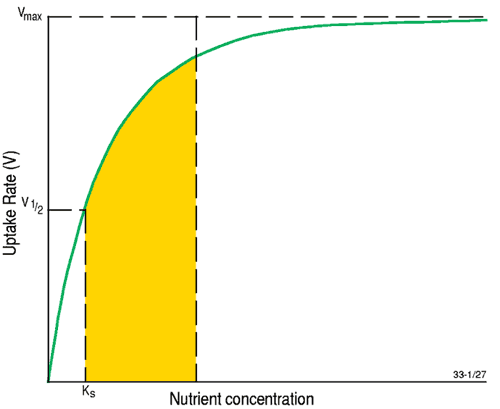
Figure 2. Relationship between plant uptake rate and nutrient concentrations in water.
Significance of excessive nutrient loads
Excessive loads of nutrients can cause the eutrophication of coastal waterways. The general pattern of change involves a shift from large macrophytes (including seagrasses) towards fast-growing macroalgae and phytoplankton (including harmful species found in blooms 16) that can capture and use light more efficiently1819. High loadings of organic matter to the sediment promotes oxygen consumption through decomposition, and can potentially lead to anoxic or hypoxic events. Low dissolved oxygen concentrations (and toxic algae) can harm benthic invertebrates, fish, and other organisms18. Nutrient enrichment can also compromise the ability of seagrass meadows and salt marshes to support fish and invertebrates even before a change in habitat areas occurs20.
Nitrification and denitrification rates can also inhibited in the absence of dissolved oxygen, and this can be an important cause of hysteresis. A reduction in denitrification efficiencies can also reinforce algal blooms by increasing water column nitrogen and phosphorus concentrations (see above). Overall, eutrophication can cause excessive primary production, a reduction in secondary production, changes in trophic structure, energy flow and nutrient dynamics, and an overall loss of species diversity18. In addition, excessive nutrient loads seldom occur in isolation but are often accompanied by toxicants, suspended sediments and microbial pathogens16.
Water column nutrients as indicators?: some worthwhile considerations
Coastal waterways with small water volumes relative to catchment sizes may receive larger nutrient loads per unit volume when catchments are developed than coastal waterways with smaller catchment size:water volume ratios. The water volumes of coastal waterways decrease with the degree of maturity. Waterways with catchments comprised of permeable sandy soils may also be at risk of eutrophication because nutrients may be readily transmitted via groundwater pathways.
Nutrient loads alone cannot dictate whether a waterway will have a nuisance plant problem21. Nutrient impacts on coastal waterways vary as a function of the loads and bioavailability of nutrients, physiological factors22, and the extent to which hydrodynamic factors (e.g. water volumes, residence times and extent of mixing) and turbidity levels modulate the stimulatory effects of nutrients on plants and algae521. To illustrate some of these points we draw your attention to differences between micro- and macro-tidal dominated estuaries (Figures 3 and 4).
Micro-tidal estuaries
Micro-tidal coastal waterways (e.g. wave-dominated estuaries, enclosed bays and shallow coastal lagoons) with limited freshwater inputs cannot readily flush nutrients and are generally considered susceptible to nutrient build-up and internal recycling. Figure 3 shows some chlorophyll a concentrations of Australian and non-Australian micro-tidal waterways plotted against DIN. Interestingly, data from micro-tidal coastal waterways in New South Wales (NSW) did not fit the linear trend evident in the North American data, but rather show a non-linear response at low DIN concentrations22. The authors provided a physiological explanation for the discrepancy – that algal cells exposed to DIN at low to medium concentrations take up DIN in roughly linear proportions. However, at higher DIN concentrations, the cells capacity to take up DIN is saturated (see also reference23 ). The increase in ambient DIN concentrations begins to be marked when chlorophyll concentrations are higher than about 15 µg l-1, highlighting that uptake, expanding biomass and biogeochemical cycling combined cannot fully utilise DIN loads22. Importantly, ambient nutrient concentrations are unlikely to be of much value as an indicator of trend in NSW lagoons as these concentrations are very insensitive to the impacts of the small to moderate nutrient loads currently experienced by these systems22.
It is acknowledged that this is not the experience in the northern hemisphere and some examination of why it may be the case is warranted. The largest loads estimated for NSW lagoons22 were among the smallest plotted from similar north American studies (see Fig 4 A,B) and it is apparent that, whilst the data appear to come from the same population, the NSW data are all at the very low end of the x and y axes. This was also the case when the data were compared to other bi-variate plots illustrating loading and chlorophyll relationships242526. Two conclusions can be drawn from these comparisons: (i) the loads currently experienced by NSW systems are considerably lower than those in the US (see also 37); and (ii) chlorophyll and DIN concentrations are much smaller meaning that it is difficult to determine a strong signal in the response variables.
Macro-tidal estuaries
In the case of tide-dominated coastal systems (e.g. deltas, estuaries and tidal creeks), strong tidal currents cause fine sediment to re-suspend. Consequently, tide-dominated waterways and macro-tidal wave-dominated waterways (mean tidal range >2m) are generally turbid, and light attenuation caused by suspended sediment is a major control on phytoplankton production and biomass152728. Strong tidal currents (mean tidal range >2m) also mix the water column and reduce the residence time of algae in the photic zone28. Consequently, nutrient concentrations have the potential to build up in the water column in these systems.
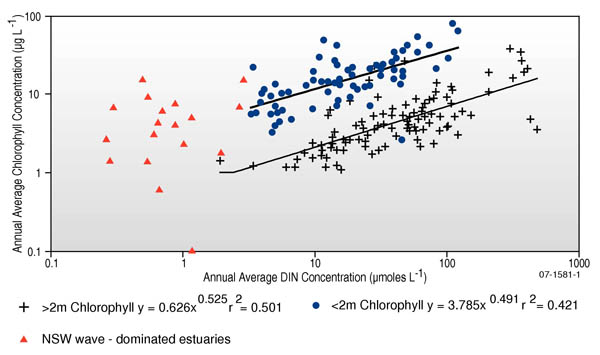
Figure 3. Annual average chlorophyll-a concentrations vs annual average dissolved inorganic nitrogen (DIN) concentrations for some non-Australian micro-tidal (tidal range 2 m) (data from Monbet (1992) 28 ) and some NSW micro-tidal estuaries (data from 22). (Image reproduced with permission of K. Hinga15 and P. Scanes (NSW Department of Environment & Conservation).
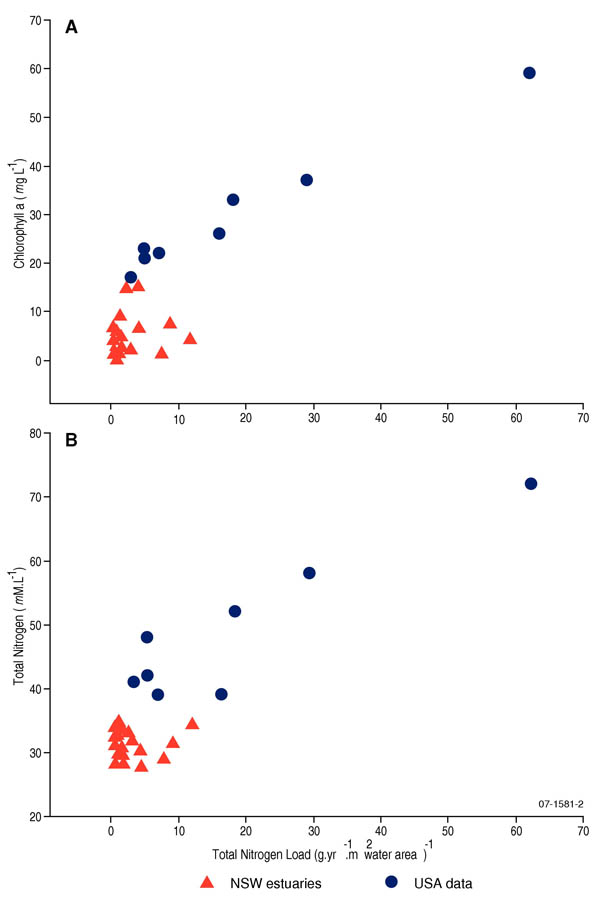
Figure 4. (A) Relationship between Total Nitrogen load and chlorophyll concentrations in NSW estuaries (2002 data22; red symbols) and US data29; blue symbols). (B) Relationship between Total Nitrogen load and Total Nitrogen concentrations in NSW estuaries (2002 data29; closed symbols) and US data ( 29; open symbols). (Image reproduced from29 with permission of P. Scanes; NSW Department of Environment & Conservation).
Considerations for measurement and interpretation
Total nitrogen and total phosphorus are determined by analysing unfiltered water samples. Dissolved nutrients pass through a 0.45µm filter and are reported as: soluble reactive phosphorus (SRP) or filterable reactive phosphorus (FRP) in the case of phosphorus; and total dissolved nitrogen (TDN) in the case of nitrogen. TDN can be further analysed for nitrate, nitrite, ammonium and organic nitrogen. The term ‘reactive’ implies that the nutrient readily reacts with the analytical chemical process.
The widely accepted analytical techniques for quantifying nutrients and producing comparable data, are a set of wet chemical processes used in combination with spectrophotometry (also termed colorimetry). The techniques involve blending precise amounts of sample and wet chemicals. A reaction occurs with the ‘reactive’ nutrient and the solution develops a specific colour. The depth of the colour is proportional to the concentration of the nutrient, and is measured with a spectrophotometer. Total nutrients are measured the same way except the nutrients being quantified are initially converted to a reactive form through a chemical digestion process. There are different techniques and instrumentation for quantifying select nutrients, such as ion chromatography, fluorescence, probes and inductively coupled plasma. When comparing data from less conventional techniques one should always confirm what form of the nutrient is being quantified. the Department of Environment, Water, Heritage and the Arts recommends that ammonium, nitrate and nitrite concentrations be measured for State of the Environment reporting30).
It is often necessary to establish which nutrients are limiting in assessing the effects of nutrient discharges on a water body. This is accomplished through the bioassay of cultures enriched with single nutrients or combinations of nutrients. For more information, guidelines and standard methods see the ANZECC/ARMCANZ Australian and New Zealand Guidelines for Fresh and Marine Water Quality (2000) and references within.
Chlorophyll-a is probably a better ‘instantaneous’ indicator of trophic status than nutrient concentrations (see Figure 3). This is because nutrient concentrations are affected by biological uptake, which in turn are influenced by uptake capabilities, interaction with grazers, temperature, turbulence and turbidity levels15. Concentrations of N (or P) taken from water column samples can also underestimate nutrient availability in a system because large pools of nutrients can be found in sediment (see sediment nutrients).
Annual nutrient loads are good indicators of annual primary production in some systems15 (see Figure 5). Production from Australian phytoplankton (green dots in Fig 5) is relatively high (in a global context) considering the small nutrient loads.
Changes in the depth distribution of seagrasses31 and the concentrations of nutrients in macroalgal tissue integrate changes over long time frames32. However, because nutrient over-enrichment disrupts the balance between carbon production and metabolism in coastal waterways, management decisions are probably best based on carbon loading rates (measured as benthic carbon dioxide flux) and related parameters (denitrification efficiency and benthic production: decomposition ratio), rather than on loadings of inorganic nutrients33.
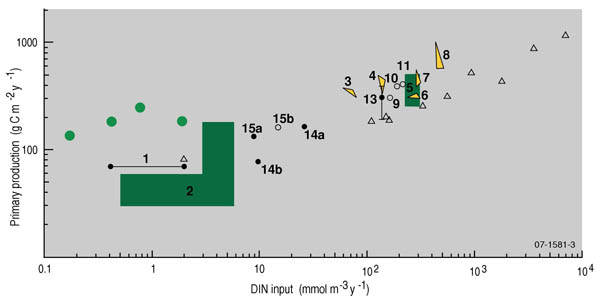
Figure 5. Annual inorganic nitrogen loads vs. primary production for some marine and coastal waterways from around the world (from Nixon 199224; reproduced with permission of Scott Nixon). Data indicated by lime green dots are based on the work of Samantha Wellman (Ph.D in prep), and are reproduced with the permission of P. Scanes (NSW Department of Environment and conservation).
Existing information and data
Trigger values for total phosphorous (TP), filterable reactive phosphate (FRP), total nitrogen, total oxidised nitrogen (e.g. NOx = NO3- + NO2-) and ammonium are provided on a bioregional basis in the ANZECC/ARMCANZ Water Quality Guidelines21. Water Quality Targets Online list water quality targets for DIN and FRP for each of ecosystem protection, recreation and aquaculture/human consumption values.
Since nutrients are routine measurements, large amounts of data exist for estuaries and coastal waterways from around Australia. The data is held by the collecting agencies (state, local government, community groups and environmental consultants). Further details can be obtained on eutrophication and nutrients from the National Eutrophication Management Program. The relationships between nutrient loads and chlorophyll-a concentrations in different types of coastal waterways can be explored using the Simple Estuarine Response Models developed by CSIRO. Conceptual Models illustrating nitrogen transport pathways in tide-dominated deltas, tide-dominated estuaries, tidal creeks, wave-dominated deltas, wave-dominated estuaries, strandplains/coastal lagoons, and embayments are available in the OzCoast and OzEstuaries database. The National Pollutant Inventory and the 2001 State of the Environment Report for Coasts and Oceans have limited data on nutrient loads (diffuse and point source) to Australia’s coastal waterways.
More information on nutrients (changed from natural).
NLWRA 2008: Estuarine, coastal and marine habitat condition, indicator guideline
Nutrient concentration in the water column and/or sediments
Research needs and questions
Given the strong influence of tidal action on water column stability and turbidity levels (which affect the potential of plants to take up nutrients), it would be advantageous to derive separate sets of default trigger values and water quality targets for tide- and wave-dominated systems. There is also a need to establish “what combination of nutrient loadings and hydrodynamic factors causes eutrophic conditions in estuarine and coastal waterways?” Hydrodynamic modelling can greatly assist in this process (see for example The Gippsland Lake Environmental Study)34.
Contributors
Ian Atkinson, Geoscience Australia
David Heggie, Geoscience Australia
Peter Scanes, Department of Environment and conservation, NSW
Lynda Radke, Geoscience Australia
What are nutrients?
The nutrients nitrogen (N) and phosphorus (P) are elements, and are essential building blocks for plant and animal growth. Nitrogen is an integral component of organic compounds such as amino acids, proteins, DNA and RNA. Phosphorus is found in nucleic acids and certain fats (phospholipids). Most of the earth’s atmosphere (~78%) is made of dinitrogen gas (N2), whereas phosphorus is a common element of igneous rocks. Chemical and biological processes transfer nitrogen and phosphorus through the lithosphere, atmosphere, hydrosphere and biosphere. This is called nitrogen and phosphorus cycling. Nitrogen-fixing bacteria convert dinitrogen gas into organic nitrogen species that can enter the hydrological cycle and food webs. Phosphorus is made biologically available through the weathering of rocks.
Silicon and several metals are also often classified as nutrients. The metals, such as copper, zinc and chromium, present at low concentrations in water, are essential for life and are called micronutrients or trace elements. However, they can become toxicants when they are found at higher than background concentrations in the environment.
Occurrence of nitrogen in coastal waterways
Nitrogen exists in water both as inorganic and organic species, and in dissolved and particulate forms. Inorganic nitrogen is found both as oxidised species (e.g. nitrate (NO3-) and nitrite (NO2- ↩
- Millero, F.J. 1996. Chemical Oceanogrpahy, 2nd Edition, CRC Press LLC. ↩
- Froelich, P.N. 1988. Kinetic control of dissolved phosphate in natural rivers and estuaries: A primer on the phosphate buffer mechanism. Limnology and Oceanography 33, 649-668. ↩
- Dennsion, W.C. and Abal, E.G. 1999. Moreton Bay Study: A Scientific Basis for the Healthy Waterways Campaign, South East Queensland Water Quality Management Strategy, pp. 245. ↩
- Harris, G.P. 2001. Biogeochemistry of nitrogen and phosphorous in Australian catchments, rivers and estuaries: effects of land use and flow regulation and comparisons with global patterns. Marine and Freshwater Research 52, 139-149. ↩ ↩
- The National Land and Water Resources Audit 2002. Australian catchment, river and estuary assessment Volume I, Commonwealth of Australia. http://www.nlwra.gov.au/ ↩
- Prosser, I.P. and Winchester, S.J. 1996. History and processes of gully initiation and development in Australia. Zeitschrift fur Geomorphologie Supplement Band 105, 91-109. ↩
- Caitcheon, G., Donnelly, T., Wallbrink, P., and Murray, A. 1995. Nutrient and sediment sources in Chaffey Reservoir catchment. Australian Journal of Soil and Water Conservation 8, 41-49. ↩
- Berelson, W.M., Heggie, D., Longmore, A., Kilgore, T., Nickolson, G., Skyring, G. 1998. Benthic nutrient recycling in Port Phillip Bay, Australia. Estuarine and Coastal Shelf Science 56, 917-934. ↩ ↩
- Zimmerman, A.R., Benner, R. (1994). Denitrification, nutrient regeneration and carbon mineralisation in sediments of Galveston Bay, Texas, USA. Marine Ecology Progress Series 114, 275-288. ↩
- Seitzinger, S.P., Nixon, S.W., Pilson, M.E.Q. (1984). Denitrification and nitrous oxide production in a coastal marine ecosystem. Limnology and Oceanography 29, 73-83. ↩
- Webb, K.L. and D’Elia, C.F. 1980. Nutrients and oxygen redistribution during a spring/neap tidal cycle in a temperate estuary. Science 207, 983-985. ↩
- Roden, E.E. and Edmonds, J.W. 1997. Phosphate mobilization in iron-rich anaerobic sediments: microbial Fe(iii) oxide reduction versus iron-sulphide formation. Arch. Hydrobiol. 139, 347-378. ↩
- Connell, D.W., and Miller, G.J. 1984. Chemistry and Ecotoxicology of Pollution. John Wiley & Sons, N.Y. ↩
- Hinga, K.R., Jeon, H. and Lewis, N.F. 1995. Marine eutrohication review I: Quantifying the effects of nitrogen enrichment on phytoplankton in coastal ecosystems. NOAA Coastal Ocean Office, Silver Spring, MD, 36p. ↩ ↩ ↩ ↩ ↩
- Anderson, D.M., Gilbert, P.M., Burkholder, J.M. 2002. Harmful algal blooms and eutrophication: Nutrient sources, composition, and consequences. Estuaries 25(4b), 704-726. ↩ ↩ ↩
- Chan, T.U. and Hamilton, D.P. 2001. Effect of freshwater flow on the succession and biomass of phytoplankton in a seasonal estuary. Marine and Freshwater Research 52, 869-884. ↩
- Nielson, J. and P. Jernakoff, P. 1996. A review of the interaction of sediment and water quality with benthic communities. Port Phillip Bay Environmental Study. Technical Report No. 25, 1-130. ↩ ↩ ↩
- Duarte, C.M. 1995. Submerged aquatic vegetation in relation to different nutrient regimes. Ophelia 41, 87-112. ↩
- Deegan, L.A. 2002. Lessons learned: The effects of nutrient enrichment on the support of nekton by seagrass and salt marsh ecosystems. Estuaries 25(4b), 727-742. ↩
- ANZECC/ARMCANZ (October 2000) Australian and New Zealand Guidelines for Fresh and Marine Water Quality. (www.ea.gov.au/water/quality/nwqms/#quality) ↩ ↩ ↩
- Scanes P., G. Coade, M. Doherty and R. Hill, 2007, Evaluation of the utility of water quality based indicators of the estuarine lagoon condition in NSW, Australia. Est. Coast. Shelf Sci. 74: 306-319. ↩ ↩ ↩ ↩ ↩ ↩ ↩
- Flynn, K.J. 1998. Estimation of kinetic parameters for the transport of nitrate and ammonium in marine phytoplankton. Marine Ecology Progress Series 169, 13-28. v ↩
- Nixon, S.W. 1992. Quantifying the relationship between nitrogen input and the productivity of marine ecosystems. Advanced Marine Technology Conference, No. 5, Japan, pp. 57-83. ↩ ↩
- Kelly J.R. 2001. Nitrogen effects on coastal marine ecosystems. In: Follett R.F., Hatfield, J.L. (eds) Nitrogen in the Environment: Sources, problems and management. Elsevier Science B.V. ↩
- Hauxwell, J., Valiela, I. 2004. Effects of nutrient loading on shallow seagrass-dominated coastal systems: Patterns and Processes in Nielson, S., Banta, G., Pedersen M. (eds) Estuarine Nutrient Cycling: The Influence of Primary Producers, 59-92. Kluwer Academic Publishers, Netherlands. ↩
- Cloern, J.E. 1987. Turbidity as a control on phytoplankton biomass and productivity in estuaries. Continental Shelf Research 7(11/12), 1367-1381. ↩
- Monbet, Y. 1992. Control of phytoplankton biomass in estuaries: A comparative analysis of microtidal and macrotidal estuaries. Estuaries 15(4), 563-571. ↩ ↩ ↩
- Boynton, W.R., Murray, L., Hagy, J.D., Stokes, C., Kemp, W.M. 1996. A comparative analysis of eutrophication patterns in a temperate coastal lagoon. Estuaries 19, 408-421. ↩ ↩ ↩ ↩
- Ward, T., Butler, E. and Hill, B. 1998. Environmental Indicators for National State of the Environment Reporting, Estuaries and the Sea, Commonwealth of Australia, pp. 81. www.ea.gov.au/soe/coasts/estuaries-ind.html ↩
- Abal, E.G. and Dennison, W.C. 1996. Seagrass depth range and water quality in southern Moreton Bay, Queensland, Australia. Marine and Freshwater Research 47, 763-771. ↩
- Lyngby, J.E. 1990. Monitoring of nutrient availability and limitation using the marine macroalgae Ceramium rubrum (Huds.) C. Ag. Aquatic Botany 38, 153-161. ↩
- Eyre, B. and A.J.P. Ferguson 2002. Sediment biogeochemical indicators for defining sustainable nutrient loads to coastal ecosystems, Proceedings of Coast to Coast 2002 – “Source to Sea”, Tweed Heads, pp. 101-104. ↩
- Cappo, M., Alongi, D.M., Williams, D, and N. Duke. 1995. A review and synthesis of Australian Fisheries Habitat Research: Major threats, issues and gaps in knowledge of coastal and marine fisheries habitats. Fisheries Research and Development Corporation. http://www.aims.gov.au/pages/research/afhr/afhr-00.html ↩


